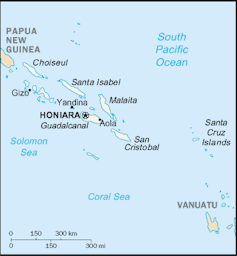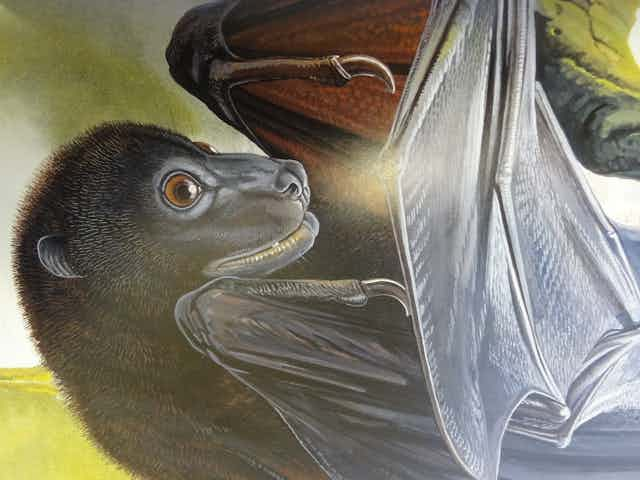The Australian Museum has announced a scientific expedition to the Solomon Islands to research a coconut cracking megabat and giant rat, with Professor Tim Flannery as one of the leaders of the program.
The expedition will be the most extensive survey of the oceanic archipelago since the 1990s and offers a rare opportunity to gain valuable insights about mammalian evolution in an isolated ecosystem.
The team will use a combination of DNA sampling, camera traps and traditional local knowledge to piece together information on the behaviour and distribution of the monkey-faced bat and giant rat. The results will influence the design of long term conservation efforts at the Solomon Islands.
The Galapagos of the Western Pacific

The Solomon Islands are a series of six major oceanic islands located in the Western Pacific Ocean. They are remarkable in that clusters of these islands have been largely isolated from major land masses throughout their geological history.
From an evolutionary biology standpoint, the Solomon Islands are invaluable as each island has developed a unique biodiversity independent of the others. Flannery has described them as “the Galapagos of the Western Pacific”.
“The islands are around 40 million years old and the fauna on each island in the chain are different,” Professor Tim Flannery told The Conversation. “They have never been connected by a land bridge, so they have both been colonised separately either by water or flown there.
"It’s like the Galapagos Islands. Take a blank slate and let the species come in and populate it.”
There are five known species of monkey-faced bat (genus Pteralopex) and at least one species of giant rat (Solomys ponceleti) that are endemic to the Solomon Islands, and the expedition leaders hope to discover more species of both.
They are also the largest mammals on the Solomon Islands. However, sightings have been few and far in between, with current knowledge limited to museum specimens and anecdotes.
There is an urgent need to gain a greater understanding of the mega-fauna, with one species of monkey-faced bat (Pteralopex flanneryi, named after Tim Flannery) and one species of giant rat (Solomys ponceleti) classified as “critically endangered” by The World Conservation Union.
Basic questions about their biology, habitat and reproduction still remain a mystery. Flannery said that the expedition will answer those questions, which are crucial to starting conservation efforts.
“We need to start building from the ground up. To design an effective conservation method we’re in that crucial information gathering stage.”
Coconut cracking megabats

What is known about the species of monkey-faced bats and giant rats found on the Solomons is that they have evolved characteristics unique to their species. In the absence of any other land based mammal, they have occupied an ecological niches no other bats or rats have ventured into before.
With a wing span of over a metre and a half, the monkey-faced bats are “megabats”, and are one of the biggest bats in the world. Their common name originates from their primate-like appearance.
“They dwarf the fruit bats around Sydney. The biggest ones are very striking, enormous black bats with big boxy heads,” said Flannery.
The monkey-faced bats in the remote Solomon Islands have evolved characteristic usually associated with monkeys. They have complex teeth and jaws so powerful it allows them able to crack green coconuts. The molars have a unusually large number of cusps and heavy incisors to break through the hard husks of the coconut. In addition the bats have a “double canine” with two big cusps.

To Flannery’s knowledge, no other mammal has that kind of unique canine.
The Solmons giant rat weighs up to two kilograms and has reproductive behaviour unseen in other rat species. The last recorded sighting in 2006 of a female and young showed that they had only one young at a time.
However Flannery explained that in the absence of any mammalian carnivores, the monkey-faced bat and giant rat did not evolve any defence mechanisms. This proved especially disastrous for the species when feral cats were introduced.
“They’re a naive species. We’ve had accounts of people taking monkey-faced bats out of tree holes and they won’t even attempt to bite you. They are just so unaware of predation.”
The brink of a new era of discovery
In addition to locating the monkey-faced bat and giant rat, the team will also be canvassing the Solomon Islands for other undiscovered native mammals. Samples will also be sent to the Australian Museum Research Institute for molecular analysis to describe species scientifically. Local community involvement will also be an invaluable component.
“We are dealing with what are probably going to be fragmented specimens. There might be an old trophy skull hanging in a house for years or a jawbone. Fragmented DNA for analysis will be a big part of our work.”

Designing a conservation program would also be crucial to ensure long term preservation of the Solomon Island biodiversity.
Despite the challenges, the research program could contribute much to the nature of mammalian conservation and research.
“The reality is that we are poised on the brink of a new era of discovery because there are so many species which have remained undetected. So there will be a new burst of activity where we will see many new species described and hopefully for the first time ever effective conservation,” said Flannery.

